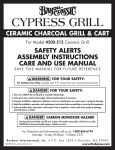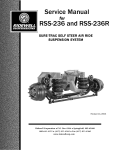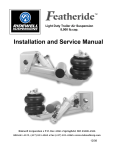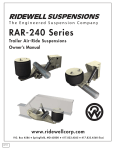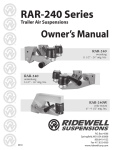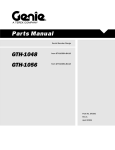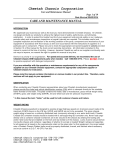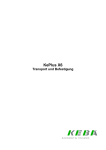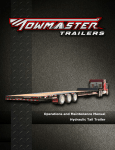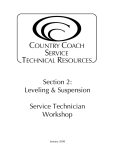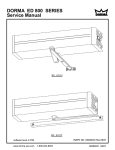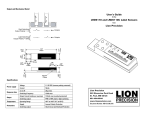Download Service Manual Light-Trac RLT-230
Transcript
Service Manual for Light-Trac RLT-230 Self-Steering Integrated Suspension System Ridewell Corporation P.O. Box 4586 Springfield, MO 65808 800-641-4122 (417) 833-4565 Fax (417) 833-4560 www.ridewellcorp.comRidewell Corporation Revised 3/2005 CONTENTS Basic Operation................................................................................................Section 1 Operational Inspection.....................................................................................Section 2 Preventative Maintenance.................................................................................Section 3 Bushing Replacement.......................................................................................Section 4 Air Control Panel..............................................................................................Section 5 Basic Troubleshooting......................................................................................Section 6 Parts Illustrations.............................................................................................Section 7 SUSPENSION IDENTIFICATION: Ridewell Suspensions are identified by a metal tag attached to the lefthand hanger that indicates part number, revision level, capacity and date of manufacture. Consult your vehicle manufacturer for your correct mounting height. PARTS: For optimum suspension performance, order only Ridewell parts. Replacement parts for Model RLT-230 are shown in Section 7 of this manual. SALES, SERVICE & WARRANTY: If you need assistance regarding this product, please contact us and we will be glad to help you. Mailing Address Ridewell Corporation P.O. Box 4586 Springfield, MO 65808 Shipping Address Ridewell Corporation 3715 E. Farm Rd. 94 Springfield, MO 65803 Phones, Fax, Email 800-641-4122, (417) 833-4565 (417) 833-4560, fax [email protected] BASIC OPERATION When properly maintained and operated within design limits, Ridewell's LIGHT-TRAC RLT-230 self-steering integrated suspension, axle and brake systems will provide many years of trouble-free service. It has several features which make it easy to operate and will keep maintenance and downtime to an absolute minimum. 1.) 2.) 3.) 4.) 5.) Extended life clamp-in urethane hanger pivot bushings for easy replacement. Parallelogram design for 100% ride on air. Cab mounted controls for axle lift-load position. Pre-set axle caster and axle alignment. Dual self-centering steering stablizers. Air Springs & Air Control System This air ride suspension is designed to provide an auxiliary or "part-time" steerable axle for the vehicle. The 4 air springs on this suspension work in conjunction to "lift" the axle off the ground when not in use and provide "load" support when in use. The air control system controls the "lift" and "load" air springs by controlling the volume of the air in the springs. xxxxx The air control system for this suspension will automatically raise the axle as the vehicle is shifted into reverse unless equipped with the optional steer lock. IMPORTANT! It is recommended the suspension be allowed 5-10 seconds to activate prior to forward and reverse operation. If the automatic lift system or steer lock fails to activate, the vehicle operator may put the axle up-down switch in the up position or cease operations and inspect for cause or failure. This will avoid causing possible damage to the suspension or axle. AIR PRESSURE & BRAKE PROTECTION VALVE The air ride suspension is dependent on air pressure from the vehicle supply system. Air pressure must be maintained above 80 p.s.i. before operation. A brake protection valve must be installed in the air system to prevent air loss below 70 p.s.i. and to insure safe air brake pressure in the event of air loss in the suspension system. SELF-CENTERING STEERING STABILIZERS The suspension is equipped with dual self-centering steering stabilizers that keep the tie rod centered while the axle is in the lifted position. They also dampen shocks and vibrations transmitted from the road through the tires. OPERATIONAL INSPECTION 1. Inspect all fasteners at hanger to frame connection. 2. Inspect for proper installation of cross members between hangers. Hangers should be adequately supported to prevent side movement. 3. Build and maintain truck air pressure to 80 p.s.i. minimum. 4. Inspect air springs. Make sure all springs inflate and do not leak. Leaks may be checked with soapy water. 5. Check all air connections for leaks and tighten if needed. 6. Inspect air lines. They should be free of sharp edge contact to prevent premature failure. 7. Alternately shift from forward to reverse to make sure axle will automatically raise and lower. PREVENTATIVE MAINTENANCE DAILY Check for loose or broken parts on or around suspension to prevent any serious problems from occurring. EVERY 30 DAYS Check clearances around all moving suspension parts, air springs, tires and shock absorbers. Any signs of interference should be immediately corrected. Visually inspect axle beam bolted connection to make sure bolts are tight and there are no signs of wear. EVERY 90 DAYS & WITH ANNUAL INSPECTION Inspect items required in daily and 30-day inspections. Inspect all welded connections. Inspect all pivot and clamping connections such as the suspension pivots and shock mounts. DO NOT PAINT THIS STICKER RIDEWELL SUSPENSION TORQUE CHART BOLT SIZE LUBRICATED THREADS 1 1/2” 1,100 FT. LB. (1,490 1 1/4” 1,000 FT. LB. (1,350 1 1/8” 500 FT. LB. (680 1” GRADE 5 360 FT. LB. (490 1” GRADE 8 460 FT. LB. (625 7/8” 350 FT. LB. (475 3/4” GRADE 5 160 FT. LB. (220 3/4” GRADE 8 190 FT. LB. (260 5/8” 100 FT. LB. (135 *3/4” 50 FT. LB. (70 *1/2” 25 FT. LB. (35 * AIR SPRING CONNECTION ONLY N·m) N·m) N·m) N·m) N·m) N·m) N·m) N·m) N·m) N·m) N·m) After suspension has been in operation for approximately 6,000 miles (10,000 KLMS), all fasteners must be re-tightened to specified torque. Repeat every 50,000 miles (80,000 KLMS). DO NOT OVER TORQUE! 990301 PIVOT B U S H I N G A N D / O R L I F T AIR S P R I N G R E P L A C E M E N T The LIGHT-TRAC RLT-230 self-steering suspensions feature an easy to replace clamp-in main hanger pivot bushing. No special tooling is required for service. The torque beam has either press-in rubber (2002 and earlier) or urethane (2002 and later) bushings. We recommend replacing both forward main bushings and both torque beam bushings when servicing is required. Individual components may be ordered. After receiving the replacement parts, service may proceed as follows: 1. Deflate all air springs. 2. Remove the 1” cap screw at the axle end of the torque beam. 3. Rotate the torque beam slightly downward and remove the five (5) bolts at the main pivot clamp. 4. Remove the torque beam and replace rubber or urethane bushing. 5. Remove the urethane bushing from hanger pivot tube. (NOTE: The bushing is pre-split along its length for easy removal and replacement.) 6. Clean the pivot tube on the hanger and apply a light coating of anti-seize to the tube. Install the new bushing. (NOTE: The lift spring may be replaced at this time if required.) 7. Re-assemble the torque beam to the lift spring arm, making sure the alignment knobs on the urethane bushing are in line with the holes in the beam and lift arm housing. 8. Assemble five (5) bolts to pivot clamp and torque to 180 ft. lbs. each. 9. Assemble 1” bolt in torque beam to lower beam pivot and torque to 360 ft. lbs. Install jam nut and torque to 100 ft. lbs. OPERATING INSTRUCTIONS AIR CONTROL PANEL UNDERSTANDING THE CONTROL PANEL The control panel is equipped with one (1) pressure regulator, one (1) air gauge, and one (1) airoperated flip switch or push/pull knob. The pressure regulator is labeled “Axle Load, Increase and Decrease” and is used to adjust the pressure in the load-air spring. The flip switch or push/pull knob is labeled “Axle Up/Down” and is used to raise or lower the axle. The air gauge displays the air pressure in the load-air spring only. TO LIFT AXLE Move flip switch or push/pull knob to the “Up” position to raise axle. This will exhaust air from the rearload springs and allow up to 100 p.s.i. into the lift springs (limited by pre-set regulator). TO LOAD AXLE Move the flip switch or push/pull knob to the “Down” position to lower tires to the ground. This will exhaust air from the lift springs and allow air to flow into rear-load springs. Slowly turn pressure regulator labeled “Axle Load” clockwise, noting the pressure reading on the air gauge. As air pressure increases, the load applied to the auxiliary axle will increase. For the desired axle load distribution, calibrate air gauge by scaling axle weights and checking air pressure. CAUTION: Do not operate suspension in “down” position with less than 30 p.s.i. shown on gauge. TRACTION CONTROL Turn pressure regulator labeled “Axle Load” counter-clockwise to reduce air pressure (load). This will transfer load to the driving axle. Turn the regulator only until the desired traction is obtained. CAUTION: Do not overload drive axle(s). SUSPENSION PERFORMANCE For trouble-free operation, follow instructions and perform maintenance as outlined on installation drawings. BASIC T R O U B L E S H O O T I N G MODEL RLT-230 (FIXED CASTER) NOTE: Do not check system until minimum 80 p.s.i. air pressure is built and maintained. 1. Tracking Improperly - Check the following: a. Excessive bushing wear b. Axle mounting bolts c. Load spring air pressure d. Steering stabilizers e. Hanger alignment 2. Axle Fails to Lift - Check the following: a. Air system and lift springs b. Solenoid and electrical c. Improper assembly of torque beam after servicing 3. Tie Rod Not Centering in Lift Position - Check the following: a. Steering stabilizers PARTS I L L U S T R A T I O N S










